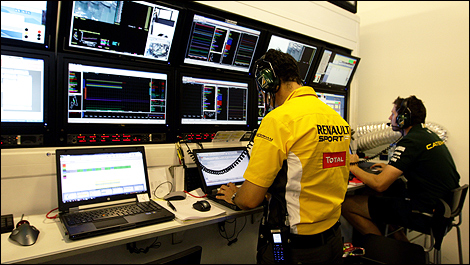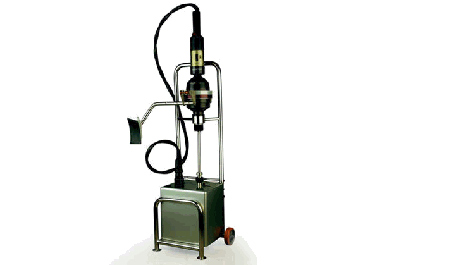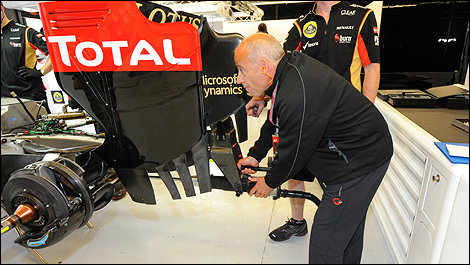Jul
18th
Stay connected Subscribe to our RSS feed
Auto123.com's Motorsport Editor, René Fagnan, had the unique opportunity to spend some time with members of the Renault Sport F1 Team to experience the thrill of starting a V8 Formula 1 engine.
In Part 1, I detailed the complex procedures of warming the engine block up to operating temperature before even trying to start it. As you know by now, it takes more than just the twist of a key to get the engine running.
Once the V8 has been warmed up, it is brought to life with a powerful external electrical starter motor. The unit consists of a 24-volt battery pack and the starter itself which attaches to the rear of the gearbox.
The starter motor features a long probe that goes inside the gearbox, along with a set of gears and a clutch. When it turns, the engine crank will turn 5 times faster than the probe.
I'm standing behind the Lotus E21 of Kimi Raikkonen. The engine cover is off, and the small Renault V8 is clearly visible. The starter has such a kick it is fitted with a reaction arm hooked up to the rear impact structure of the Lotus. The starter is made to be reliable, not light.
I put my earplugs and listen to the instructions given by Henry Saint-Michel, engine technician at Renault Sport F1, who is responsible for Raikkonen's car at Lotus.
First, I need to crank the engine freely to get the oil circulating and bring it to the correct pressure.
“The chief mechanic will tell you to press the button. Then, I will tell you when to stop”, says Saint-Michel.
Finally, I get the thumbs up and press the button. The starter motor is quite noisy, and the kick I feel is quite impressive. I now fully understand why the starter is hooked up to the rear beam of the car!
After about 10 seconds, Saint-Michel tells me to stop. We repeat the procedure: I press the button for another 10 seconds.
Everything's going fine. By releasing a red button located on the work station, Saint-Michel now allows the engine to be fired.
Thumbs up. I push the button, and the moment the V8 comes alive, I quickly remove the starter by vigorously pulling it back. The stunning sound of the V8 awakening just inches from my head, along with a blast of 600-degree exhaust gases, makes me appreciate every second of my experience!
In Part 1, I detailed the complex procedures of warming the engine block up to operating temperature before even trying to start it. As you know by now, it takes more than just the twist of a key to get the engine running.
 |
| Renault check the running of its engines using telemetry. (Photo: Renault Sport F1) |
Once the V8 has been warmed up, it is brought to life with a powerful external electrical starter motor. The unit consists of a 24-volt battery pack and the starter itself which attaches to the rear of the gearbox.
The starter motor features a long probe that goes inside the gearbox, along with a set of gears and a clutch. When it turns, the engine crank will turn 5 times faster than the probe.
I'm standing behind the Lotus E21 of Kimi Raikkonen. The engine cover is off, and the small Renault V8 is clearly visible. The starter has such a kick it is fitted with a reaction arm hooked up to the rear impact structure of the Lotus. The starter is made to be reliable, not light.
I put my earplugs and listen to the instructions given by Henry Saint-Michel, engine technician at Renault Sport F1, who is responsible for Raikkonen's car at Lotus.
 |
| F1 electric starter. (Photo: Archives Auto123.com) |
First, I need to crank the engine freely to get the oil circulating and bring it to the correct pressure.
“The chief mechanic will tell you to press the button. Then, I will tell you when to stop”, says Saint-Michel.
Finally, I get the thumbs up and press the button. The starter motor is quite noisy, and the kick I feel is quite impressive. I now fully understand why the starter is hooked up to the rear beam of the car!
After about 10 seconds, Saint-Michel tells me to stop. We repeat the procedure: I press the button for another 10 seconds.
 |
| Auto123.com's René Fagnan operating the starter! (Photo: Paolo Pedicelli) |
Everything's going fine. By releasing a red button located on the work station, Saint-Michel now allows the engine to be fired.
Thumbs up. I push the button, and the moment the V8 comes alive, I quickly remove the starter by vigorously pulling it back. The stunning sound of the V8 awakening just inches from my head, along with a blast of 600-degree exhaust gases, makes me appreciate every second of my experience!
 The latest auto news, reviews, prices, product and vehicle releases.
The latest auto news, reviews, prices, product and vehicle releases.